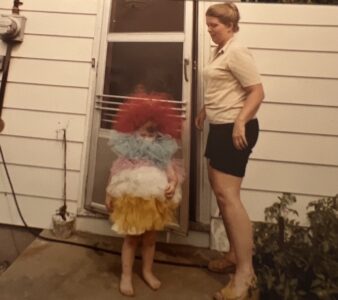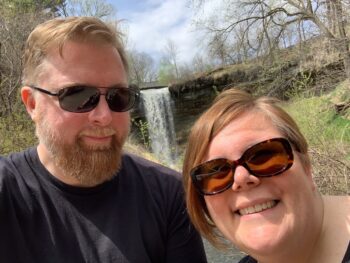 By Pastor Norma Malfatti
By Pastor Norma Malfatti
Last week my brother came to visit; it was so good to be together. This is the first time he’s come to Minneapolis that we could explore the area and we went on some fabulous adventures. However, the real reason he came to visit was to help me continue to go through our mother’s things.
It’s been 15 months since she died and there is still much to tend to when it comes to her stuff and our father’s stuff too. He died 15 years ago and yet my mother hadn’t been ready to go through some of the boxes of his precious things and practice some Marie Kondo magic. Regardless, I am now the caretaker of a lot of stuff and the people at my local Goodwill are getting to know me well.
If you’ve ever gone through things from your childhood, you know that it can bring up a variety of feelings as you sort through the treasures of the past. Seeing a picture that captures the time my older sister and I decided to make our brother wear all of our many tutus at the same time had me yearning for simpler (to me) times, when our biggest worry was whether or not we’d get a time out for our antics. After capturing a photo on my phone and texting it to my sister, I put it in its proper box and moved onto the next picture.
“The world is different than it was before the pandemic and the world watched George Floyd’s murder on electronic devices.”
Svetlana Boym, a cultural theorist and former professor at Harvard University, calls this reflective nostalgia, longing for the past while acknowledging that the past cannot be recreated and may not even be as idyllic as we remember. Restorative nostalgia, on the other hand, seeks to recreate the past, in the present. Boym writes, “Restorative nostalgia does not think of itself as nostalgia, but rather as truth and tradition.” It’s what my siblings and I do when we get dinner from the same chain restaurant in three different states on our parents’ birthdays because it was their favorite haunt.
I ALSO THOUGHT ABOUT the church as I sorted through boxes and boxes of knickknacks, baking supplies, pictures, and more. Even though there’s an Omicron variant running through the Twin Cities and elsewhere in the country, we seem to have entered a new phase of the pandemic where we are trying to create some normalcy. I wonder if these two types of nostalgia can help us figure out what that normalcy will look like.
Restorative nostalgia would have us attempt to recreate the past; to seek to revive all the committees, ministries, and other contextually important structures and events that were a part of our congregations in 2019. Reflective nostalgia would have us examine our pre-pandemic ways of being (ministries, teams, liturgies, etc.) and wonder whether they serve us and the community now, no matter how faithful and effective they were three years ago.
“I thought about the church as I sorted through boxes and boxes of knickknacks, baking supplies, pictures, and more.”
The answer might be yes, but it could just as easily be no. The world is different than it was before the pandemic and the world watched George Floyd’s murder on electronic devices. No matter how hard we try, we will never be able to recreate life as we knew it in those before times because we know what’s happened since then. Our ignorance cannot be recaptured.
I’m not saying that any of these conversations are easy and won’t be fraught with grief and a struggle for some to figure out their place and role. But, I do think Christians are called to have such discussions if we are going to figure out who God is calling any individual congregation, the synod, and the entire ELCA into the changed world we’re venturing into.
 If you’re wondering how you might approach these kinds of conversations in your own congregation, I think Dr. Thema Bryant, a professor of psychology at Pepperdine University has wisdom to offer. At the Festival of Homiletics this week, she talked about post-traumatic growth and used Jesus’ crucifixion as the case study.
If you’re wondering how you might approach these kinds of conversations in your own congregation, I think Dr. Thema Bryant, a professor of psychology at Pepperdine University has wisdom to offer. At the Festival of Homiletics this week, she talked about post-traumatic growth and used Jesus’ crucifixion as the case study.
First, after the trauma he spent some time in rest — what she called “tomb time.” Take time just to be still after the trauma and heal. Perhpas there are ministries or programs that just need to take a pause as leaders figure out what’s next. There is no harm in taking a break, and the time will help peoples’ anxiety lower, which can help them engage in reflective nostalgia making space for vision and change.
“Our ignorance cannot be recaptured.”
Be honest without being judgmental. You were living into the ministry you thought was most faithful at the time. Whether your answer was “great” or “could have been better,” will your ministry help you live out your purpose today?When you’re ready to start the conversaiont about what’s next, you may want to talk first about how you’ve changed as individuals and as a congregation. You may want to give testimony to how you survived the last few years. Naming how you’ve changed will help you dig deeper into the question of “why.”
Why does your congregation/team exist? Has the answer to that question changed in the last three years? Do you think it should? How well were you living up to that “why” before the pandemic? Be honest without being judgmental; you were living into the ministry you thought was most faithful at the time. Whether your answer was “great” or “could have been better,” will your ministry help you live out your purpose today?
No matter how these conversations go (or have already gone), hear God’s words to Joshua as God’s words to you this day: “As I was with Moses, so I will be with you; I will not fail you or forsake you. … I hereby command you: Be strong and courageous; do not be frightened or dismayed, for the Lord your God is with you wherever you go.” (Joshua 1:5b, 9 NRSV)
